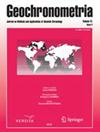伊朗东北部Gandab火山岩U-Pb年代学、Sr-Nd地球化学、岩石成因及构造背景
IF 1.2
4区 地球科学
Q3 Earth and Planetary Sciences
引用次数: 2
摘要
本文论述了甘达布火山岩的U-Pb地质年代学、Sr-Nd地球化学、岩石成因和构造环境。Gandab火山岩属于Sabzevar带岩浆弧(伊朗东北部)。从岩石学角度来看,所有研究的火山岩都显示出含斜长石、钾长石、角闪石、辉石和磁铁矿斑晶的斑状结构,这些斑晶嵌入细粒至中等粒度的岩体中。此外,在一些岩石中还可以看到杏仁状和尖晶状结构。标准化学分类表明,所研究的岩石为玄武质管安质岩、管安山岩、管安岩和管英安岩。主要元素表明,所研究的样品为金属铝,其氧化铝饱和度指数在0.71至1.02之间。球粒陨石归一化稀土元素和地幔归一化微量元素模式显示,相对于重稀土元素(HREE),轻稀土元素(LREE)富集,相对于高场强元素(HFSE),大离子亲石元素(LILE)富集。此外,它们还显示出轻微的负Eu异常(Eu/Eu*=0.72–0.97)。所研究岩石的全岩地球化学表明,它们通过分级结晶相互关联。来自两个火山岩样品(GCH-119和GCH-171)的锆石颗粒的LA-MC-ICP-MS U-Pb分析给出的年龄范围为5.47±0.22 Ma至2.44±0.79 Ma,对应于上新世。在四个分析Sr和Nd同位素的样品中,87Sr/86Sr比值在0.704082至0.705931之间,εNd值在+3.34至+5之间变化。这些数值可以被视为代表地幔衍生的岩浆。考虑到稀土元素(REE)模式的比较,提出了富集岩石圈地幔母岩浆的起源。最后得出结论,上新世甘达布火山岩与新特提斯俯冲后的碰撞后环境有关。本文章由计算机程序翻译,如有差异,请以英文原文为准。
U-Pb geochronology, Sr-Nd geochemistry, petrogenesis and tectonic setting of Gandab volcanic rocks, northeastern Iran
Abstract This paper addresses U-Pb geochronology, Sr-Nd geochemistry, petrogenesis and tectonic setting in the Gandab volcanic rocks. The Gandab volcanic rocks belong to the Sabzevar zone magmatic arc (northeastern Iran). Petrographically, all the studied volcanic rocks indicate porphyritic textures with phenocrysts of plagioclase, K-feldespar, hornblende, pyroxene, and magnetite which are embedded in a fine to medium grained groundmass. As well, amygdaloidal, and poikilitic textures are seen in some rocks. The standard chemical classifications show that the studied rocks are basaltic trachy andesite, trachy andesite, trachyte, and trachy dacite. Major elements reveal that the studied samples are metaluminous and their alumina saturation index varies from 0.71 to 1.02. The chondrite-normalized rare earth element and mantle-normalized trace element patterns show enrichment in light rare earth elements (LREE) relative to heavy rare earth elements (HREE) and in large ion lithophile elements (LILE) relative to high field strength elements (HFSE). As well they show a slightly negative Eu anomaly (Eu/Eu* = 0.72 – 0.97). The whole-rock geochemistry of the studied rocks suggests that they are related to each other by fractional crystallization. LA-MC-ICP-MS U-Pb analyses in zircon grains from two volcanic rock samples (GCH-119 and GCH-171) gave ages ranging of 5.47 ± 0.22 Ma to 2.44 ± 0.79 Ma, which corresponds to the Pliocene period. In four samples analysed for Sr and Nd isotopes 87Sr/86Sr ratios range from 0.704082 to 0.705931 and εNd values vary between +3.34 and +5. These values could be regarded to as representing mantle derived magmas. Taking into account the comparing rare earth element (REE) patterns, an origin of the parental magmas in enriched lithospheric mantle is suggested. Finally, it is concluded that Pliocene Gandab volcanic rocks are related to the post-collision environment that followed the Neo-Tethys subduction.
求助全文
通过发布文献求助,成功后即可免费获取论文全文。
去求助
来源期刊

Geochronometria
地学-地球科学综合
CiteScore
2.20
自引率
0.00%
发文量
1
审稿时长
>12 weeks
期刊介绍:
Geochronometria is aimed at integrating scientists developing different methods of absolute chronology and using them in different fields of earth and other natural sciences and archaeology. The methods in use are e.g. radiocarbon, stable isotopes, isotopes of natural decay series, optically stimulated luminescence, thermoluminescence, EPR/ESR, dendrochronology, varve chronology. The journal publishes papers that are devoted to developing the dating methods as well as studies concentrating on their applications in geology, palaeoclimatology, palaeobiology, palaeohydrology, geocgraphy and archaeology etc.
 求助内容:
求助内容: 应助结果提醒方式:
应助结果提醒方式:


